Wakayama Castle
-Dragon on the back of Tiger Hill-
Overview
Name: Wakayama castle (Wakayama-jo)
Alias:
Place: Ichiban-cho Wakayama city, Wakayama
Location: 34.22790535460696, 135.1723821124566
Type: Hill Castle
Built: Originally in 1580's, expanded in 17th century
Remaining remnants: Gates, stone walls and moats
Title: 100 famous Japanese castles
Wakayama castle (和歌山城) is located on and around Torafusuyama hill (Lying tiger hill), one of 50 meter height at the center of Wakayama city. Wakayama city places at the mouth of Kinokawa river, and an important point to connect Osaka area, Yoshino area at upstream of Kinokawa river, and south part of Wakayama prefecture.
Wakayama castle is one of the three castles of special relative domain of Edo Shogunate, along with Nagoya castle (Aichi prefecture) and Mito castle (Ibaraki prefecture). Also due to its size and dignity, Wakayama castle is regarded as three famous hill castles along with Himeji castle (Hyogo prefecture) and Hikone castle (Shiga prefecture).
In the Muromachi era, Kii province (Wakayama prefecture) was goverened by Hatakeyama clan. Hatakeyama clan was a traditional family and descendent of Shigetada Hatakeyama (1164-1205), a brave general under Yoritomo Minamoto (1147-1199) and contributed to the establishment of Kamakura Shogunate.
Hatakeyama clan was once destroyed due to the revolt to Hojyo clan, a regent of Kamakura Shogunate, but Kamakura Shoguhate let the person of Ashikaga clan to succeed the name of Hatakeyama clan. Later Ashikaga clan established Muromachi Shogunate, and Hatakeyama clan became a high class retainer of Shogunate.
The main stream of Hatakeyama clan served as the governor of Kawachi and Izumi province (south half of Osaka prefecture) and Kii country, and the branch house became the governor of Noto country (north half of Ishikawa prefecture). But the situation of Kii country in Muromachi era was complex, as north part of Kii province were kept by strong local armed group such as Saika party or Negoro soldiers.
Saika party was a kind of armed civilian lived at current east part of Wakayama city and performed autonomy, They were a kind of armed merchants, and later they became famous as mercenary matchlock gunners. Negoro soldiers were monk soldiers of Negoro-dera temple, and also known as another matchlock gunners.
In addition to this, in the south part of Kii province such as Arita town or Gobo town were held by strong local lords such as Yukawa clan or Yamamoto clan. They located in the steep mountains and Hagakeyama clan could not force them to give in.
Due to these reasons, Hatakeyama clan only kept the middle part of Kii province such as current Kainan city and their power were quite limited in Kii province. Nevertheless as a governor of Kawachi province, Hatakeyama clan struggled against ruler of Kinki region such as Hosokawa clan or Miyochi clan, but this weakened the power and authority of Hatakeyama clan.
When Nobunaga Oda (1534-1582), the warlord of Owari country (western half of Aichi prefecture) marched to Kyoto city and became the central ruler, Hatakeyama clan supported Oda clan as they were the enemy of Miyoshi clan. Negoro soldiers were also hired by Nobunaga, but Saika group resisted to Nobunaga in cooperation with Ishiyama Honganji temple.
In 1577 Nobunaga attacked Saika area with a large army, but Saika group tormented Nobunaga army by guerrilla tactics. This time the both party tentatively made peace, but tension between them continued.
After the death of Nobunaga at the incident of Honnoji in 1582, his general Hideyoshi Toyotomi (1537-1598) defeated Mitsuhide Akechi (1528-1582) who made a coup d’etat against Nobunaga and became the substantial successor. Hideyoshi grasped Kinki region, and fought for former colleagues such as Katsuie Shibata (1522-1583) for the next hegemony. Further Hideyoshi fought wiht Ieyasu Tokugawa (1543-1616), former ally of Nobunaga and who supported Nobunaga’s son.
During this process, Saika party and Negoro soldiers hostiled to Hideyoshi, and attacked Osaka area where the main base of Hideyoshi. Hideyoshi built Kishiwada castle (Kishiwada city) for the defense base of this area, and after the battle of Komaki Nagakute against Ieyasu in 1584, Hideyoshi started his campaign against Kii province to protect Osaka area.
In March 1585, eventually Hideyoshi started his action against Kii country. At first Hideyoshi attacked front forts of Negoro group built in Izumi province, and Hideyoshi army suffered certain damage but fell it in one day. Next Hideyoshi attacked Negoro-dera temple, and the temple was burnt down except for large tower remains until now.
Finally Hideyoshi attacked Saika people besieged at Ota castle, and utilizeing the terrain of Ota castle as a marsh near large river, Hideyoshi built the embankment and performed flood attack. After one month battle. Saika party surrendered to Hideyoshi and leaders were executed. Local lord of south areas kept resistance for half years, but finally surrendered to Hideyoshi and now whole Kii province was grasped by Toyotomi government.
Hideyoshi who captured Kii country gave the country to Hidenaga Toyotomi (1540-1591), his most trusted younger brother who already governed Yamato province (Nara prefecture). Hidenaga chose Wakayama area as the main base of Kii province, because 1) it was close to Saika area and Negorodera temple and suitable to monitor them, 2) this area is connected to Yoshino area by Kinokawa river and suitable to control river trade such as woods, and 3) it was north edge of Kii province and close to Osaka area, and convenient to send the reinforcement in case of rebellion.
There was already a small fort built by Hatakayema clan at the Torafusuyama hill, but Hidenaga ordered his general Takatora Todo (1556-1630), who was later known as a master of building castle, to build a new castle at this place. Stone wall of hilltop area were mainly built at this period, and originally the central area was located at the place of next peak of current central area, the place of water delivery equipment. Current central area were originally the secondary area. Hilltop area consist of folding low stone walls affected by terrain shape, and still kept the atmosphere of medieval castle.
As Hidenaga himself located at his main base Koriyama castle (Nara prefecture), he placed his retainer Shigeharu Kuwayama (1524-1606) as a commander of Wakayama castle. Shigeharu kept Wakayama castle by the battle of Sekigahara in 1600 and improvement of the castle was kept.
After the battle of Sekigahara, Yoshinaga Asano (1576-1613) formerly the lord of Kofu castle (Yamanashi prefecture) became the lord of Wakayama castle. Yoshinaga was the son of Nagamasa Asano (1547-1611), who was the brother in row of One, the wife of Hideyoshi Toyotomi. After the death of Hideyoshi, Asano clan supported Ieyasu Tokugawa and became the large lord which owned whole part of Kii province.
Yoshinaga significantly expanded Wakayama castle as a residence of large lord. A three story main tower connected with three corner turrets with corridor was newly built at former secondary area. Main tower had the same shape as current one, but covered by black wall boards. The hillside area was expanded into northeast ward and became the new secondary area, then the palace formerly located at hilltop area moved to this secondary area.
Wide moat covered secondary area, and main gate was newly built at this side. Additionaly, outer moats surrounded castle town were made utilizing rivers. Asano clan further made achievement at the battle of Osaka castle in 1614 and 1615, and later moved to Hiroshima castle of Aki province (Hiroshima prefecture) after the confiscation of territory of Masanori Fukushima (1561-1624) in 1619.
After Asano clan, Yorinobu Tokugawa (1602-1671), the tenth son of Ieyasu, became the lord of Kii domain and lived at Wakayama castle. Kii domain was one of “Gosanke” (special relative house which stem from direct son of Ieyasu) along with Owari domain at Nagoya castle and Mito domain at Mito castle.
These three houses are expected to watch the movement of neighbor lords, and in case of rebellion they became the core of the regional army and hold the enemy until arrival of reinforcement from Shogunate. Further if the main stream of Shogunate became extinct, next Shogun were to be selected from these three houses.
Yoribobu was a fortitude person and activated at the battle of Osaka castle in 1614 and 1615. To save unemployed soldiers Yorinobu hired these soldiers and further expanded Wakayama castle. Yorinobu became the last survivor of Ieyasu’s direct son, and due to its character and power of the clan, he was called as “Dragon of the southern sea” and sometimes regarded as looking for the position of Shogun.
In 1651, a master of military named Shosetsu Yui (1605-1651) planned to rebellion to Edo Shogunate with other unemployed samurais. Shosetsu used the name of Yorinomu wituout permission and Yorinobu was suspected, but Yorinobu explained to Shogunate and avoided panishment.
During the time of Yorinobu, Wakayama castle was further expanded into northwest ward. Tall stone walls were also built at the south side of the hill, to guard this side where directly faced next hills. Yorinobu further planned to expand the castle into the south hill, and if realized Wakayama castle might be the huge one of 1,000 meter length and 500 meter width. But considering above situation, this expansion plan was cancelled.
Kishu domain produced two Shogun during Edo era. Yoshimune Tokugawa (1684-1751) made achievement of the restoration of financial problem of the domain, and later became eighth Shogun in 1716. Yoshimune also proceeded reform at Shogunate called as “Reform of Kyoho”, and restored the finance of Shogunate.
Yoshinobu was regarded as good monarch, and still a hero in historical drama who punishes bad magistrates directly. Later Iemochi Tokugawa (1846-1866) became the 14th Shogun among anti-Shogunate movement, but finally failed at the campaign against Choshu domain and triggered the collapse of Edo Shogunate.
In 1846, due to the lightning most building were burnt down. But as a special relative house, reconstruction of buildings including main tower was exceptionally permitted and completed in 1850. Subsequent to Meiji revolution, many building were lost and central palace was moved to Osaka castle (lost in 1947).
Buildings of central area including main tower were preserved, but finally burnt down in the air bombing at World War 2 in 1945, along with Nagoya castle and Mito castle. But still two gates remain as original, and main towers were reconstructed in 1958. Castles of three special relative house has each feature, it means traditional style clay castle (Mito castle), Toyotomi style hill castle (Wakayama castle) and Tokugawa style plain castle (Nagoya castle). Comparison of these castles is interesting.
25 minutes walk from JR West Kisei Honsen line Wakayama station. 15 minutes drive from Hanwa Jidoshado Expressway Wakayama interchange.
Nagoya Castle -Residence of future ruler-
Mito Castle -Castle of three branch Tokugawa families closest to Edo-
Himeji Castle -Castle of Kanbe and Hideyoshi-
Hikone Castle -Red colored armored army of Ii clan-
Hiroshima Castle -Deviation from clan's tradition on castle-
Type: Hill Castle
Built: Originally in 1580's, expanded in 17th century
Remaining remnants: Gates, stone walls and moats
Title: 100 famous Japanese castles
Brief History
Wakayama castle (和歌山城) is located on and around Torafusuyama hill (Lying tiger hill), one of 50 meter height at the center of Wakayama city. Wakayama city places at the mouth of Kinokawa river, and an important point to connect Osaka area, Yoshino area at upstream of Kinokawa river, and south part of Wakayama prefecture.
Wakayama castle is one of the three castles of special relative domain of Edo Shogunate, along with Nagoya castle (Aichi prefecture) and Mito castle (Ibaraki prefecture). Also due to its size and dignity, Wakayama castle is regarded as three famous hill castles along with Himeji castle (Hyogo prefecture) and Hikone castle (Shiga prefecture).
Medieval era of Kii province
In the Muromachi era, Kii province (Wakayama prefecture) was goverened by Hatakeyama clan. Hatakeyama clan was a traditional family and descendent of Shigetada Hatakeyama (1164-1205), a brave general under Yoritomo Minamoto (1147-1199) and contributed to the establishment of Kamakura Shogunate.
Hatakeyama clan was once destroyed due to the revolt to Hojyo clan, a regent of Kamakura Shogunate, but Kamakura Shoguhate let the person of Ashikaga clan to succeed the name of Hatakeyama clan. Later Ashikaga clan established Muromachi Shogunate, and Hatakeyama clan became a high class retainer of Shogunate.
The main stream of Hatakeyama clan served as the governor of Kawachi and Izumi province (south half of Osaka prefecture) and Kii country, and the branch house became the governor of Noto country (north half of Ishikawa prefecture). But the situation of Kii country in Muromachi era was complex, as north part of Kii province were kept by strong local armed group such as Saika party or Negoro soldiers.
Rise of Saika party and Negoro monk soldiers
Saika party was a kind of armed civilian lived at current east part of Wakayama city and performed autonomy, They were a kind of armed merchants, and later they became famous as mercenary matchlock gunners. Negoro soldiers were monk soldiers of Negoro-dera temple, and also known as another matchlock gunners.
In addition to this, in the south part of Kii province such as Arita town or Gobo town were held by strong local lords such as Yukawa clan or Yamamoto clan. They located in the steep mountains and Hagakeyama clan could not force them to give in.
Due to these reasons, Hatakeyama clan only kept the middle part of Kii province such as current Kainan city and their power were quite limited in Kii province. Nevertheless as a governor of Kawachi province, Hatakeyama clan struggled against ruler of Kinki region such as Hosokawa clan or Miyochi clan, but this weakened the power and authority of Hatakeyama clan.
Conquest by Nobunaga and Hideyoshi
When Nobunaga Oda (1534-1582), the warlord of Owari country (western half of Aichi prefecture) marched to Kyoto city and became the central ruler, Hatakeyama clan supported Oda clan as they were the enemy of Miyoshi clan. Negoro soldiers were also hired by Nobunaga, but Saika group resisted to Nobunaga in cooperation with Ishiyama Honganji temple.
In 1577 Nobunaga attacked Saika area with a large army, but Saika group tormented Nobunaga army by guerrilla tactics. This time the both party tentatively made peace, but tension between them continued.
After the death of Nobunaga at the incident of Honnoji in 1582, his general Hideyoshi Toyotomi (1537-1598) defeated Mitsuhide Akechi (1528-1582) who made a coup d’etat against Nobunaga and became the substantial successor. Hideyoshi grasped Kinki region, and fought for former colleagues such as Katsuie Shibata (1522-1583) for the next hegemony. Further Hideyoshi fought wiht Ieyasu Tokugawa (1543-1616), former ally of Nobunaga and who supported Nobunaga’s son.
End of self governance of Saika party and Negoro soldiers
During this process, Saika party and Negoro soldiers hostiled to Hideyoshi, and attacked Osaka area where the main base of Hideyoshi. Hideyoshi built Kishiwada castle (Kishiwada city) for the defense base of this area, and after the battle of Komaki Nagakute against Ieyasu in 1584, Hideyoshi started his campaign against Kii province to protect Osaka area.
In March 1585, eventually Hideyoshi started his action against Kii country. At first Hideyoshi attacked front forts of Negoro group built in Izumi province, and Hideyoshi army suffered certain damage but fell it in one day. Next Hideyoshi attacked Negoro-dera temple, and the temple was burnt down except for large tower remains until now.
Finally Hideyoshi attacked Saika people besieged at Ota castle, and utilizeing the terrain of Ota castle as a marsh near large river, Hideyoshi built the embankment and performed flood attack. After one month battle. Saika party surrendered to Hideyoshi and leaders were executed. Local lord of south areas kept resistance for half years, but finally surrendered to Hideyoshi and now whole Kii province was grasped by Toyotomi government.
Build of Wakayama castle
Hideyoshi who captured Kii country gave the country to Hidenaga Toyotomi (1540-1591), his most trusted younger brother who already governed Yamato province (Nara prefecture). Hidenaga chose Wakayama area as the main base of Kii province, because 1) it was close to Saika area and Negorodera temple and suitable to monitor them, 2) this area is connected to Yoshino area by Kinokawa river and suitable to control river trade such as woods, and 3) it was north edge of Kii province and close to Osaka area, and convenient to send the reinforcement in case of rebellion.
There was already a small fort built by Hatakayema clan at the Torafusuyama hill, but Hidenaga ordered his general Takatora Todo (1556-1630), who was later known as a master of building castle, to build a new castle at this place. Stone wall of hilltop area were mainly built at this period, and originally the central area was located at the place of next peak of current central area, the place of water delivery equipment. Current central area were originally the secondary area. Hilltop area consist of folding low stone walls affected by terrain shape, and still kept the atmosphere of medieval castle.
As Hidenaga himself located at his main base Koriyama castle (Nara prefecture), he placed his retainer Shigeharu Kuwayama (1524-1606) as a commander of Wakayama castle. Shigeharu kept Wakayama castle by the battle of Sekigahara in 1600 and improvement of the castle was kept.
Expansion under Asano clan
After the battle of Sekigahara, Yoshinaga Asano (1576-1613) formerly the lord of Kofu castle (Yamanashi prefecture) became the lord of Wakayama castle. Yoshinaga was the son of Nagamasa Asano (1547-1611), who was the brother in row of One, the wife of Hideyoshi Toyotomi. After the death of Hideyoshi, Asano clan supported Ieyasu Tokugawa and became the large lord which owned whole part of Kii province.
Yoshinaga significantly expanded Wakayama castle as a residence of large lord. A three story main tower connected with three corner turrets with corridor was newly built at former secondary area. Main tower had the same shape as current one, but covered by black wall boards. The hillside area was expanded into northeast ward and became the new secondary area, then the palace formerly located at hilltop area moved to this secondary area.
Wide moat covered secondary area, and main gate was newly built at this side. Additionaly, outer moats surrounded castle town were made utilizing rivers. Asano clan further made achievement at the battle of Osaka castle in 1614 and 1615, and later moved to Hiroshima castle of Aki province (Hiroshima prefecture) after the confiscation of territory of Masanori Fukushima (1561-1624) in 1619.
Residence of "Dragon of the southern sea"
After Asano clan, Yorinobu Tokugawa (1602-1671), the tenth son of Ieyasu, became the lord of Kii domain and lived at Wakayama castle. Kii domain was one of “Gosanke” (special relative house which stem from direct son of Ieyasu) along with Owari domain at Nagoya castle and Mito domain at Mito castle.
These three houses are expected to watch the movement of neighbor lords, and in case of rebellion they became the core of the regional army and hold the enemy until arrival of reinforcement from Shogunate. Further if the main stream of Shogunate became extinct, next Shogun were to be selected from these three houses.
Yoribobu was a fortitude person and activated at the battle of Osaka castle in 1614 and 1615. To save unemployed soldiers Yorinobu hired these soldiers and further expanded Wakayama castle. Yorinobu became the last survivor of Ieyasu’s direct son, and due to its character and power of the clan, he was called as “Dragon of the southern sea” and sometimes regarded as looking for the position of Shogun.
In 1651, a master of military named Shosetsu Yui (1605-1651) planned to rebellion to Edo Shogunate with other unemployed samurais. Shosetsu used the name of Yorinomu wituout permission and Yorinobu was suspected, but Yorinobu explained to Shogunate and avoided panishment.
During the time of Yorinobu, Wakayama castle was further expanded into northwest ward. Tall stone walls were also built at the south side of the hill, to guard this side where directly faced next hills. Yorinobu further planned to expand the castle into the south hill, and if realized Wakayama castle might be the huge one of 1,000 meter length and 500 meter width. But considering above situation, this expansion plan was cancelled.
Afterward of Wakayama castle
Kishu domain produced two Shogun during Edo era. Yoshimune Tokugawa (1684-1751) made achievement of the restoration of financial problem of the domain, and later became eighth Shogun in 1716. Yoshimune also proceeded reform at Shogunate called as “Reform of Kyoho”, and restored the finance of Shogunate.
Yoshinobu was regarded as good monarch, and still a hero in historical drama who punishes bad magistrates directly. Later Iemochi Tokugawa (1846-1866) became the 14th Shogun among anti-Shogunate movement, but finally failed at the campaign against Choshu domain and triggered the collapse of Edo Shogunate.
In 1846, due to the lightning most building were burnt down. But as a special relative house, reconstruction of buildings including main tower was exceptionally permitted and completed in 1850. Subsequent to Meiji revolution, many building were lost and central palace was moved to Osaka castle (lost in 1947).
Buildings of central area including main tower were preserved, but finally burnt down in the air bombing at World War 2 in 1945, along with Nagoya castle and Mito castle. But still two gates remain as original, and main towers were reconstructed in 1958. Castles of three special relative house has each feature, it means traditional style clay castle (Mito castle), Toyotomi style hill castle (Wakayama castle) and Tokugawa style plain castle (Nagoya castle). Comparison of these castles is interesting.
Access
25 minutes walk from JR West Kisei Honsen line Wakayama station. 15 minutes drive from Hanwa Jidoshado Expressway Wakayama interchange.
Related Castles
Nagoya Castle -Residence of future ruler-
Mito Castle -Castle of three branch Tokugawa families closest to Edo-
Himeji Castle -Castle of Kanbe and Hideyoshi-
Hikone Castle -Red colored armored army of Ii clan-
Hiroshima Castle -Deviation from clan's tradition on castle-













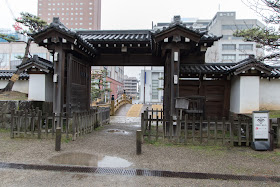




















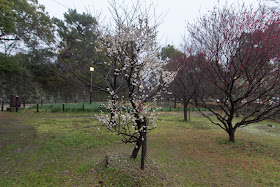





























































































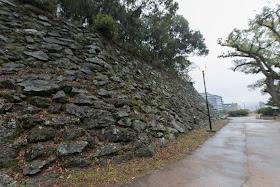








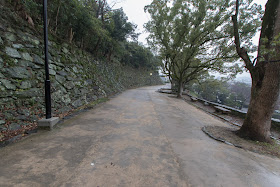












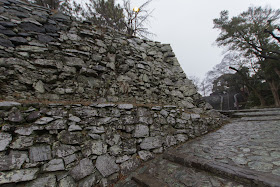
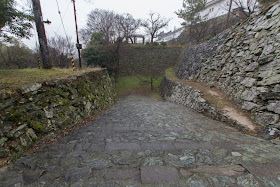



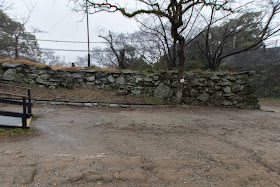































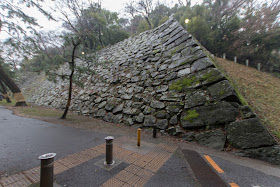




















































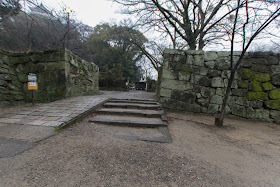


















































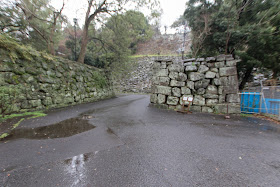




































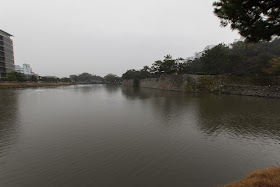




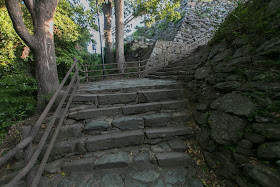












































































No comments:
Post a Comment